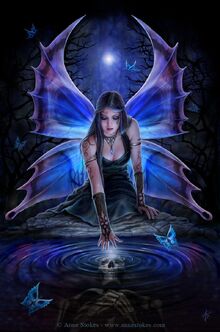A Fairy (also fay, fae; from faery, faerie, "realm of the fays") is a type of mythical being or legendary creature inEuropean folklore, a form of spirit, often described as metaphysical, supernatural or preternatural.
Characteristics[]

Fairies are generally described as human in appearance and having magical powers. Their origins are less clear in the folklore, being variously dead, or some form of demon, or a species completely independent of humans or angels. Folklorists have suggested that their actual origin lies in a conquered race living in hiding, or in religious beliefs that lost currency with the advent of Christianity. These explanations are not necessarily incompatible, and they may be traceable to multiple sources.
Much of the folklore about fairies revolves around protection from their malice, by such means as cold iron (iron is like poison to fairies, and they will not go near it) or charms of rowan and herbs, or avoiding offense by shunning locations known to be theirs. In particular, folklore describes how to prevent the fairies from stealing babies and substituting changelings, and abducting older people as well. Many folktales are told of fairies, and they appear as characters in stories from medieval tales of chivalry, to Victorian fairy tales, and up to the present day in modern literature.
In his manuscript, The Secret Commonwealth of Elves, Fauns and Fairies, Reverend Robert Kirk, minister of the Parish of Aberfoyle, Stirling, Scotland, wrote in 1691:
Although in modern culture they are often depicted as young, sometimes winged, humanoids of small stature, they originally were depicted quite differently: tall, radiant, angelic beings or short, wizened trolls being two of the commonly mentioned forms. Diminutive fairies of one kind or another have been recorded for centuries, but occur alongside the human-sized beings; these have been depicted as ranging in size from very tiny up to the size of a human child. Even with these small fairies, however, their small size may be magically assumed rather than constant. Some fairies though normally quite small were able to dilate their figures to imitate humans.
Wings, while common in Victorian and later artwork of fairies, are very rare in the folklore; even very small fairies flew with magic, sometimes flying on ragwortstems or the backs of birds. Nowadays, fairies are often depicted with ordinary insect wings or butterfly wings.
Various animals have also been described as fairies. Sometimes this is the result of shape shifting on part of the fairy, as in the case of the selkie (seal people); others, like the kelpie and various black dogs, appear to stay more constant in form.
In some folklore fairies have green eyes and often bite. Though they can confuse one with their words, fairies cannot lie. They hate being told 'thank you', as they see it as a sign of one forgetting the good deed done, and, instead, want something that will guarantee remembrance.
Origins[]
The early modern fairies do not have any single origin, representing a conflation of disparate elements of folk belief, influenced by literature and by learned speculation (e.g. alchemy). In folklore, they are variously regarded as a "natural" but hidden species, as spirits of the dead, or as descendants of either fallen angels or demons. Fairies are generally described as human in appearance and having magical powers. Their origins are less clear in the folklore, being variously dead, or some form of demon, or a species completely independent of humans or angels. The folkloristic or mythological elements combine Celtic,Germanic and Greco-Roman elements.
Another theory is that the fairies were originally worshiped as minor goddesses, such as nymphs or tree spirits, but with the coming of Christianity, they lived on, in a dwindled state of power, in folk belief. In this particular time, fairies were reputed by the church as being 'evil' beings. Many beings who are described as deities in older tales are described as "fairies" in more recent writings. Victorian explanations of mythology, which accounted for all gods as metaphors for natural events that had come to be taken literally, explained them as metaphors for the night sky and stars. According to this theory, fairies are personified aspects of nature and deified abstract concepts such as ‘love’ and ‘victory’ in the pantheon of the particular form of animistic nature worship reconstructed as the religion of Ancient Western Europe.
Many of the Irish tales of the Tuatha Dé Danann refer to these beings as fairies, though in more ancient times they were regarded as goddesses and gods. The Tuatha Dé Danann were spoken of as having come from islands in the north of the world or, in other sources, from the sky. After being defeated in a series of battles with other otherworldly beings, and then by the ancestors of the current Irish people, they were said to have withdrawn to the sídhe (fairy mounds), where they lived on in popular imagination as "fairies."